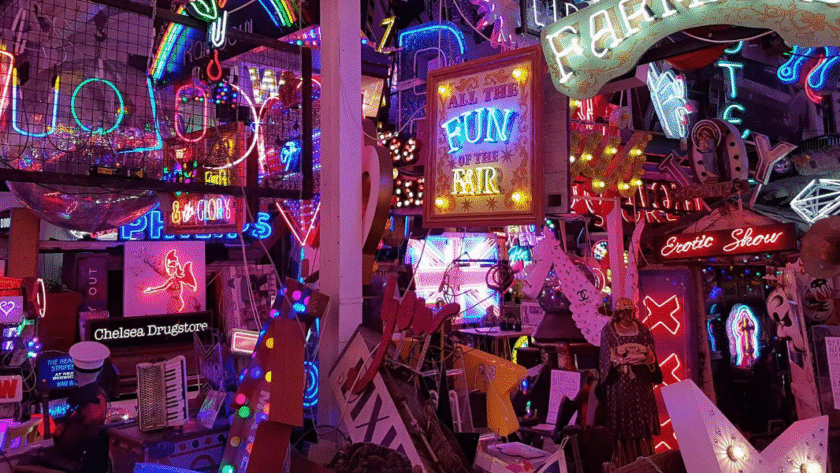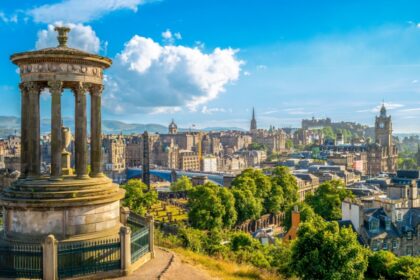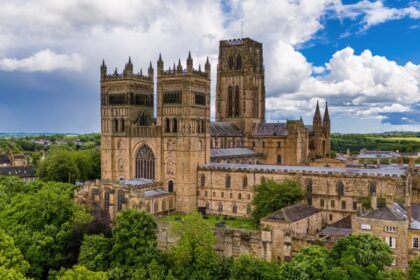There is nothing wrong with liking Big Ben. It is a cheerful little beacon of punctuality, and frankly, if a city is going to have an iconic landmark, it might as well be a clock that knows what time it is. But London is not the sort of place you can sum up in one photo from Westminster Bridge. It is a patchwork novel, scribbled in every available margin over two thousand years. This is a place where a side street can whisk you from Dickens to Blade Runner in under five minutes, and a quiet pint might come with a story about Lenin and a lamppost. The trick is not to try and see it all. The trick is to get a little lost.
Chimneys and turbine halls at Battersea Power Station
Let us begin down by the river, beside Battersea Power Station. Once a hulking red-brick chimney farm that filled the Thames with coal-smoke, it now looks like a playground built by retired superheroes. Since its grand reopening in 2022, more than 22 million people have popped in to browse the shops, stroll the park or ride the lift up the chimney. Yes, the chimney. Lift 109 shoots you 109 metres up through one of the old stacks and plonks you on a viewing platform with a full panoramic view of London. It is absurd and brilliant and entirely London.
Digital dreams under Tottenham Court Road
From here it is just a few tube stops to Tottenham Court Road, where a strange thing is happening beneath the pavement. Outernet London is part art gallery, part sci-fi cave, and mostly LED screen. The Now Building is wrapped inside and out with digital panels so crisp they make real life look pixelated. One moment you are wading through lilies with Monet, the next you are staring up at a Tyrannosaurus mid-snarl. And just when you think it is all over, music drifts up from the underground venue below, turning the lobby into something like an aquarium designed by David Bowie.
Tilework and time travel at Leighton and Sambourne Houses
For something older and altogether quieter, point yourself towards Kensington and the newly spruced-up Leighton House. It was once the home of Frederic Leighton, a Victorian painter who clearly felt that tiled walls, domes and gold leaf were perfectly reasonable things to put in a London townhouse. Thanks to a rather magnificent renovation, you now enter through a bright, modern wing with a café and a learning centre, which gently delivers you into the riotous colour of the original house. Just round the corner is Sambourne House, where Edward Linley Sambourne of Punch magazine fame lived out his days surrounded by sketches and late Victorian clutter. Visiting both in one afternoon feels like time travel with tea breaks.
Neon nostalgia in Walthamstow’s glowing warehouse
For those who prefer neon to nineteenth-century tiles, the answer lies up in Walthamstow. Here, behind an unassuming industrial door, you will find God’s Own Junkyard, a kaleidoscope of salvaged signs, luminous slogans and electric angels. Chris Bracey, the man behind it, spent decades hoarding unwanted neon from Soho and Hollywood until one day he decided to stick the whole lot in a warehouse and open a café. The result is part gallery, part fever dream, and all glow. The café is called Rolling Scones, which tells you everything you need to know.
Woodland stillness and castle views at Oxleas Wood
But even London has green corners where you can hear yourself think. Oxleas Wood in the southeast is one such spot. It is one of the last remaining stretches of proper ancient woodland in the city and has been untouched by ploughs since Norman times. Clamber up the slope and you will find Severndroog Castle, a dainty little Gothic tower built to celebrate a forgotten naval victory. The views are grand, the rope swings are slightly alarming, and the air smells of leaf mould and old stories. You will almost certainly lose phone signal, which is a blessing in disguise.
Silliness and science at Novelty Automation
And then there is Novelty Automation in Holborn. This is not a phrase you expect to read, and frankly the place is no easier to describe. Imagine a tiny arcade full of hand-built machines that do things like simulate divorce, allow you to launder fake money, or crash-test small rodents. The mastermind behind all this is Tim Hunkin, who appears to have channelled every GCSE science lesson and seaside postcard joke into a single, whirring, blinking room. It is delightful and ridiculous and somehow very London indeed.
The joy of detours and London’s cabinet of curiosities
The best part about all these places is how snugly they fit into a regular day. You can do the lions in Trafalgar Square, pop into the National Gallery for a spot of Caravaggio, then catch the tube to Walthamstow to buy a glowing pink flamingo. London specialises in surprises that feel like punchlines. A telephone box turns out to be a museum. A brick wall sings. You never know what is round the next corner, which is precisely why it is worth turning it.
Because that is the secret. London is not just about the big names. It is a city made of asides and footnotes, of curious detours and small marvels hiding in plain sight. Keep one eye on the clock tower, by all means. But save the other for a glowing junkyard or a woodland turret or a very determined lift inside a chimney. That is where the real story lives.





